10Spring源码-分析篇-AOP源码分析
Posted 波波烤鸭
tags:
篇首语:本文由小常识网(cha138.com)小编为大家整理,主要介绍了10Spring源码-分析篇-AOP源码分析相关的知识,希望对你有一定的参考价值。

Spring源码-AOP分析
一、手写AOP回顾
本文我们开始讲解Spring中的AOP原理和源码,我们前面手写了AOP的实现,了解和自己实现AOP应该要具备的内容,我们先回顾下,这对我们理解Spring的AOP是非常有帮助的。
1. 涉及的相关概念
先回顾下核心的概念,比如:Advice,Pointcut,Aspect等
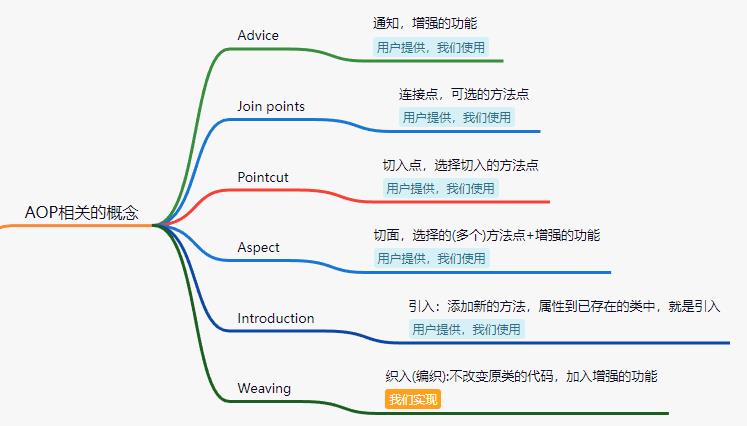
更加形象的描述:

2. 相关核心的设计
Advice:

Pointcut:

Aspect:
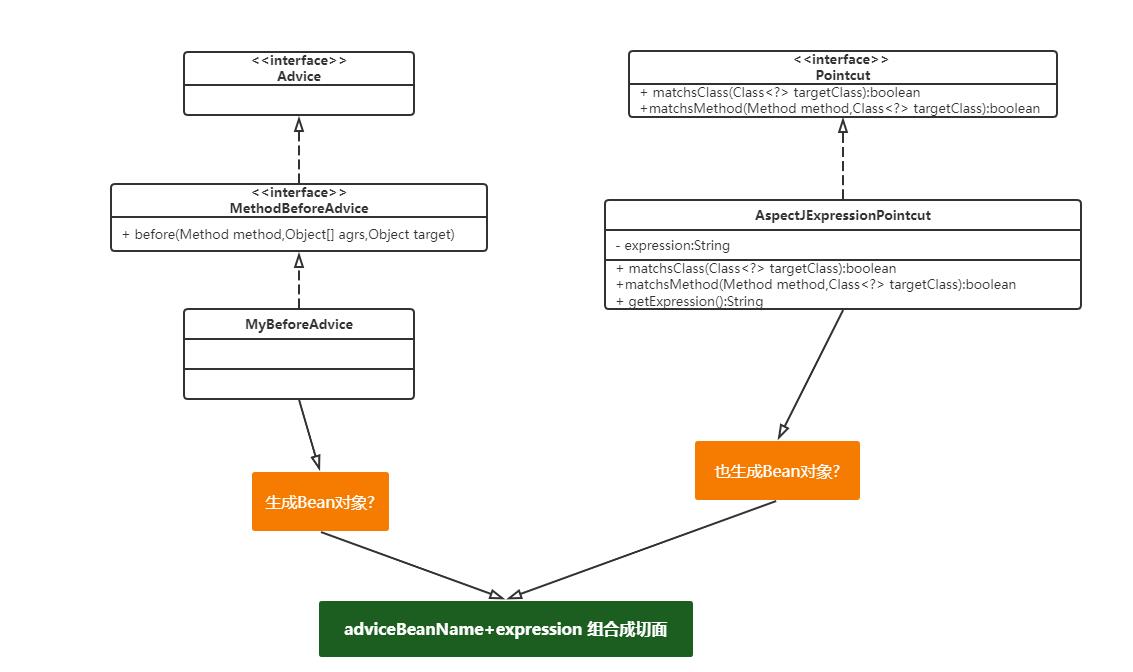
Advisor:

织入:


二、AOP相关概念的类结构
回顾了前面的内容,然后我们来看看Spring中AOP是如何来实现的了。
1. Advice类结构
我们先来看看Advice的类结构,advice–》通知,需要增强的功能

相关的说明

2. Pointcut类结构
然后来看看Pointcut的设计,也就是切入点的处理。

Pointcut的两种实现方式

3. Advisor类结构
Advisor的类结构比较简单。一个是PointcutAdvisor,一个是IntroductionAdvisor

我们要看的重点是 PointcutAdvisor 及实现 AspectJPointcutAdvisor。
三、织入的实现
1. BeanPostProcessor
1.1 案例演示
我们通过案例来看,首先使用AOP来增强。
定义切面类
/**
* 切面类
*/
@Component
@EnableAspectJAutoProxy
@Aspect
public class AspectAdviceBeanUseAnnotation
// 定义一个全局的Pointcut
@Pointcut("execution(* com.study.spring.sample.aop.*.do*(..))")
public void doMethods()
@Pointcut("execution(* com.study.spring.sample.aop.*.service*(..))")
public void services()
// 定义一个Before Advice
@Before("doMethods() and args(tk,..)")
public void before3(String tk)
System.out.println("----------- AspectAdviceBeanUseAnnotation before3 增强 参数tk= " + tk);
@Around("services() and args(name,..)")
public Object around2(ProceedingJoinPoint pjp, String name) throws Throwable
System.out.println("--------- AspectAdviceBeanUseAnnotation arround2 参数 name=" + name);
System.out.println("----------- AspectAdviceBeanUseAnnotation arround2 环绕-前增强 for " + pjp);
Object ret = pjp.proceed();
System.out.println("----------- AspectAdviceBeanUseAnnotation arround2 环绕-后增强 for " + pjp);
return ret;
@AfterReturning(pointcut = "services()", returning = "retValue")
public void afterReturning(Object retValue)
System.out.println("----------- AspectAdviceBeanUseAnnotation afterReturning 增强 , 返回值为: " + retValue);
@AfterThrowing(pointcut = "services()", throwing = "e")
public void afterThrowing(JoinPoint jp, Exception e)
System.out.println("----------- AspectAdviceBeanUseAnnotation afterThrowing 增强 for " + jp);
System.out.println("----------- AspectAdviceBeanUseAnnotation afterThrowing 增强 异常 :" + e);
@After("doMethods()")
public void after(JoinPoint jp)
System.out.println("----------- AspectAdviceBeanUseAnnotation after 增强 for " + jp);
/*
* BeanDefinitionRegistryPostProcessor BeanFactoryPostProcessor
* InstantiationAwareBeanPostProcessor Bean实例创建前后 BeanPostProcessor
*/
需要增强的目标类
@Component
public class BeanQ
public void do1(String task, int time)
System.out.println("-------------do1 do " + task + " time:" + time);
public String service1(String name)
System.out.println("-------------servce1 do " + name);
return name;
public String service2(String name)
System.out.println("-------------servce2 do " + name);
if (!"s1".equals(name))
throw new IllegalArgumentException("参数 name != s1, name=" + name);
return name + " hello!";
测试代码
@Configuration
@ComponentScan
public class AopMainAnno
public static void main(String[] args)
ApplicationContext context = new AnnotationConfigApplicationContext(AopMainAnno.class);
BeanQ bq = context.getBean(BeanQ.class);
bq.do1("task1", 20);
System.out.println();
bq.service1("service1");
System.out.println();
bq.service2("s1");
执行即可看到增强的效果
1.2 @EnableAspectJAutoProxy
我们需要使用代理增强处理,必须添加@EnableAspectJAutoProxy才生效。我们来看看他做了什么事情



在registerOrEscalateApcAsRequired方法中会把上面的Java类注入到容器中。

所以我们需要看看 AnnotationAwareAspectJAutoProxyCreator 的结构
1.3 AnnotationAwareAspectJAutoProxyCreator
我们直接来看类图结构,可以发现其本质就是一个 BeanPostProcessor ,只是扩展了更多的功能。

那么具体处理的逻辑
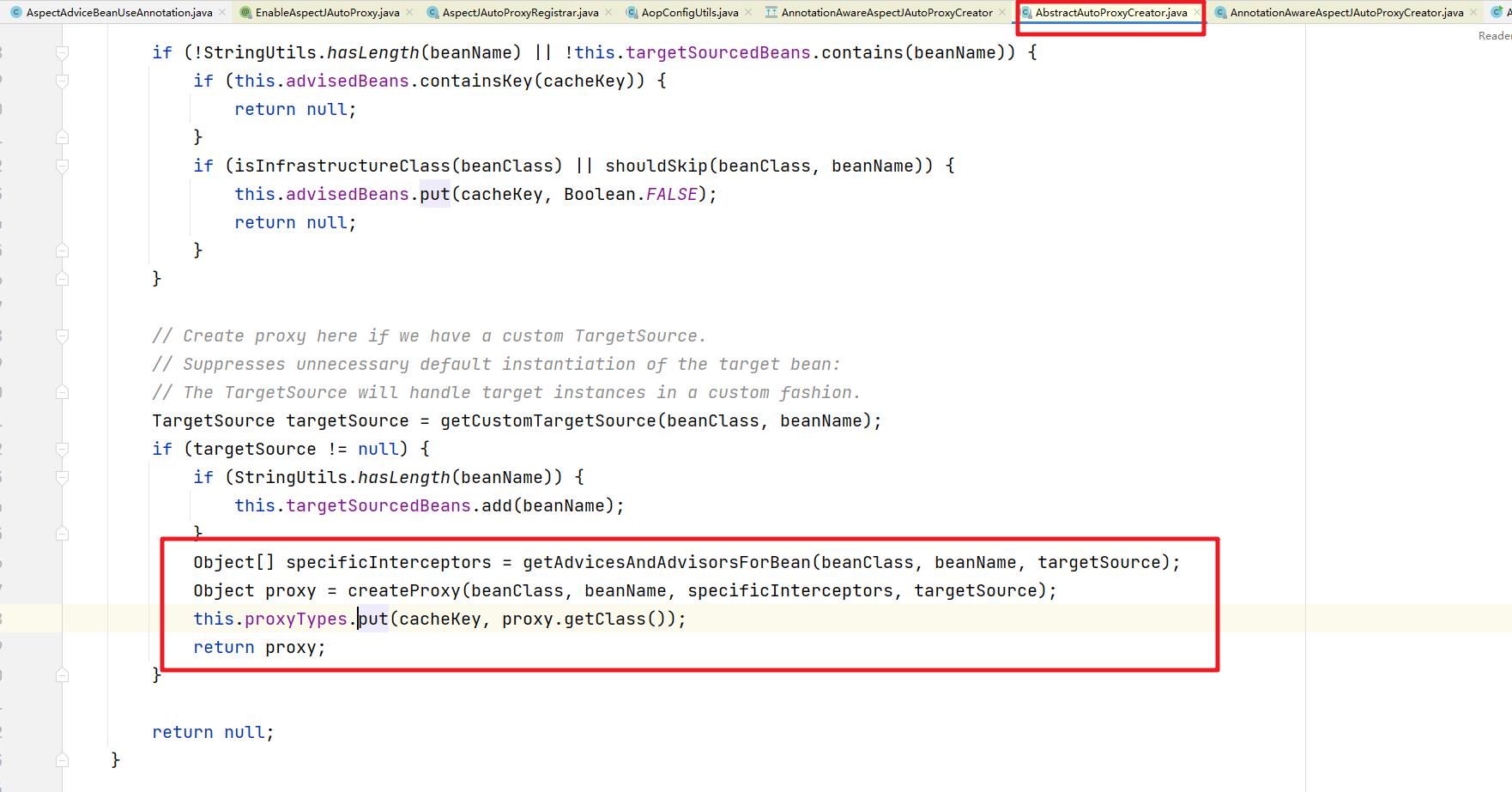
1.4 如何串联
Bean的IoC是如何和对应的BeanPostProcessor串联的呢?我们来看看。

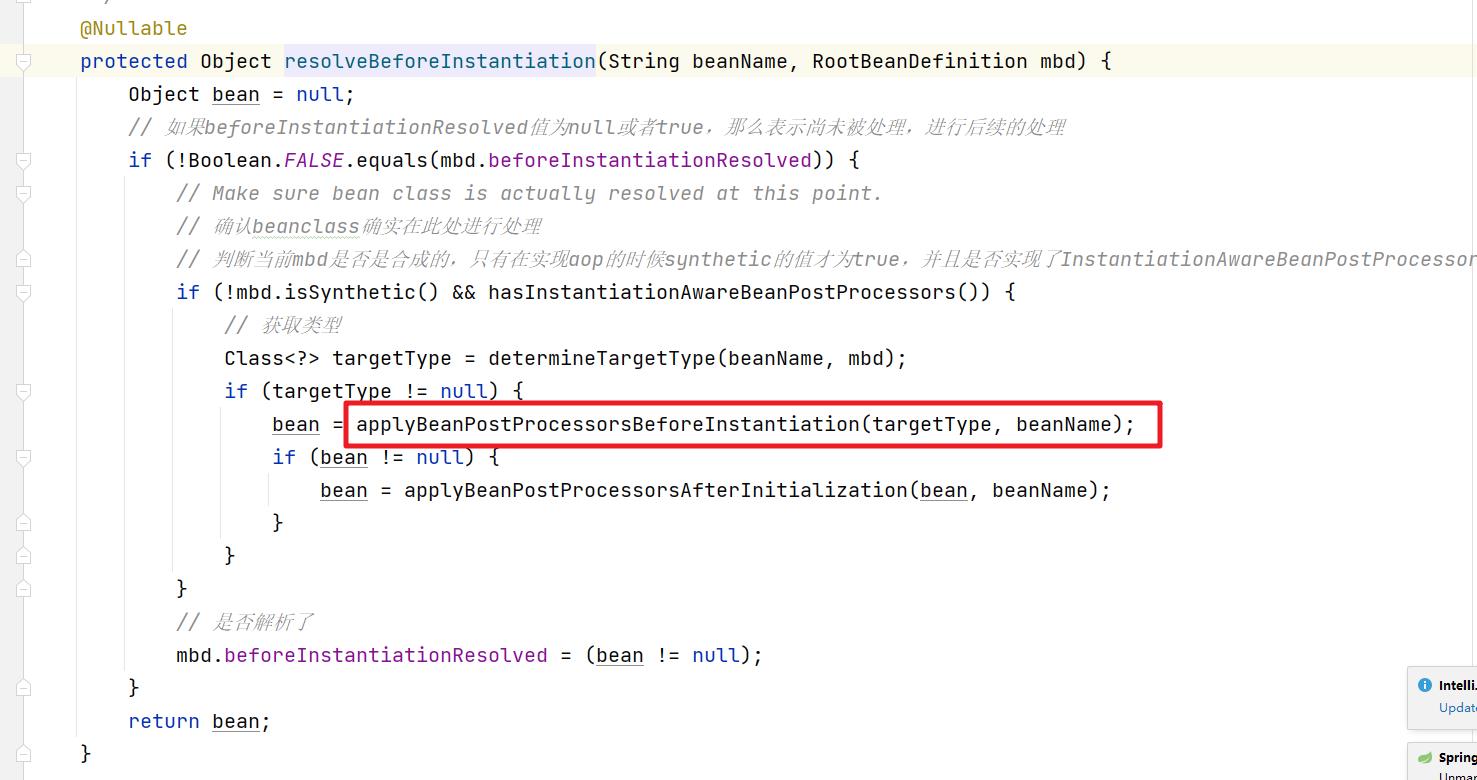


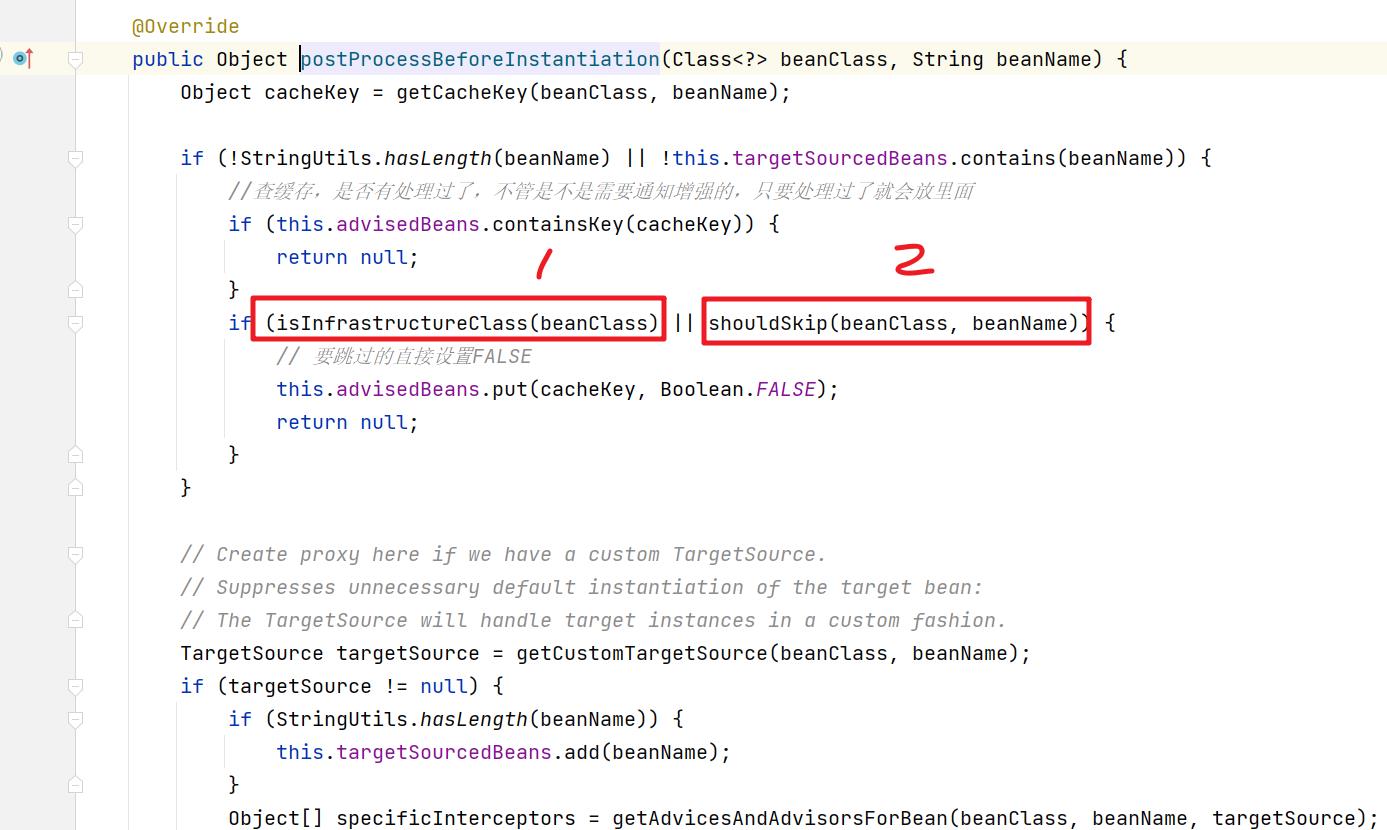
isInfrastructureClass方法判断是否是基础设施

shouldSkip:是否应该跳过,会完成相关的advisor的收集

具体的处理流程
public List<Advisor> findAdvisorBeans()
// Determine list of advisor bean names, if not cached already.
String[] advisorNames = this.cachedAdvisorBeanNames;
if (advisorNames == null)
// Do not initialize FactoryBeans here: We need to leave all regular beans
// uninitialized to let the auto-proxy creator apply to them!
// 获取当前BeanFactory中所有实现了Advisor接口的bean的名称
advisorNames = BeanFactoryUtils.beanNamesForTypeIncludingAncestors(
this.beanFactory, Advisor.class, true, false);
this.cachedAdvisorBeanNames = advisorNames;
if (advisorNames.length == 0)
return new ArrayList<>();
// 对获取到的实现Advisor接口的bean的名称进行遍历
List<Advisor> advisors = new ArrayList<>();
// 循环所有的beanName,找出对应的增强方法
for (String name : advisorNames)
// isEligibleBean()是提供的一个hook方法,用于子类对Advisor进行过滤,这里默认返回值都是true
if (isEligibleBean(name))
// 如果当前bean还在创建过程中,则略过,其创建完成之后会为其判断是否需要织入切面逻辑
if (this.beanFactory.isCurrentlyInCreation(name))
if (logger.isTraceEnabled())
logger.trace("Skipping currently created advisor '" + name + "'");
else
try
// 将当前bean添加到结果中
advisors.add(this.beanFactory.getBean(name, Advisor.class));
catch (BeanCreationException ex)
// 对获取过程中产生的异常进行封装
Throwable rootCause = ex.getMostSpecificCause();
if (rootCause instanceof BeanCurrentlyInCreationException)
BeanCreationException bce = (BeanCreationException) rootCause;
String bceBeanName = bce.getBeanName();
if (bceBeanName != null && this.beanFactory.isCurrentlyInCreation(bceBeanName))
if (logger.isTraceEnabled())
logger.trace("Skipping advisor '" + name +
"' with dependency on currently created bean: " + ex.getMessage());
// Ignore: indicates a reference back to the bean we're trying to advise.
// We want to find advisors other than the currently created bean itself.
continue;
throw ex;
return advisors;
2. 代理类的结构
在上面的分析中出现了很多代理相关的代码,为了更好的理解,我们来梳理下Spring中的代理相关的结构
2.1 AopProxy
在Spring中创建代理对象都是通过AopProxy这个接口的两个具体实现类来实现的,也就是jdk和cglib两种方式。

2.2 AopProxyFactory
在Spring中通过AopProxyFactory这个工厂类来提供AopProxy。
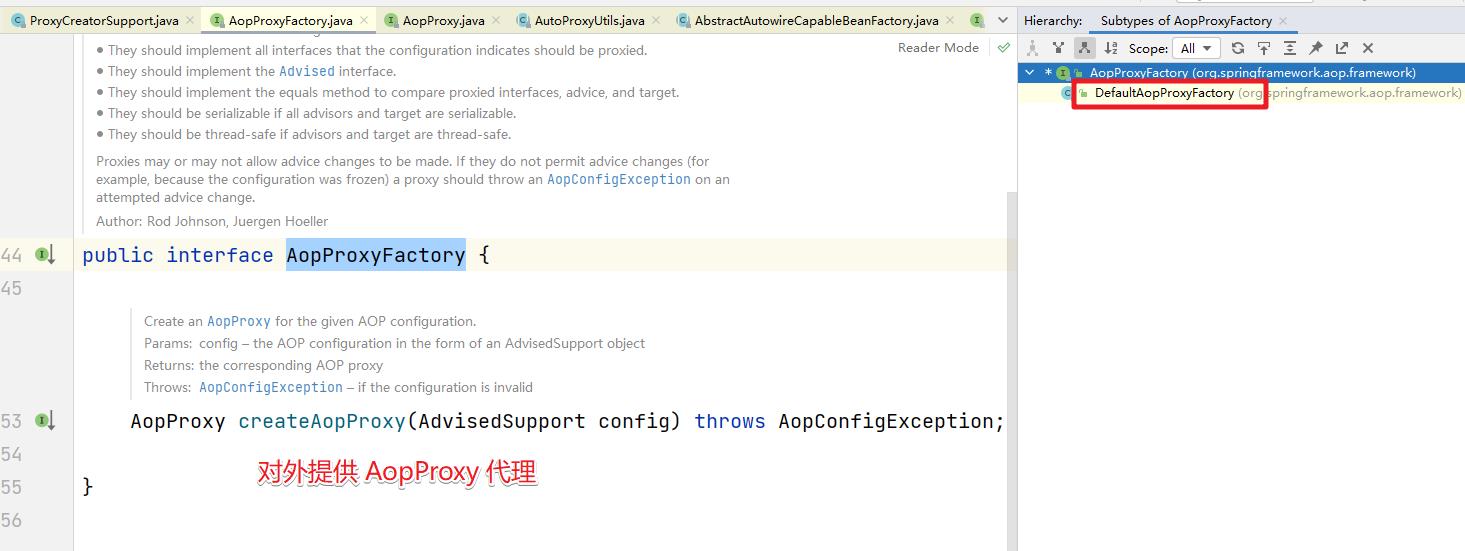
默认的实现类是DefaultAopProxyFactory
/**
* 真正的创建代理,判断一些列条件,有自定义的接口的就会创建jdk代理,否则就是cglib
* @param config the AOP configuration in the form of an
* AdvisedSupport object
* @return
* @throws AopConfigException
*/
@Override
public AopProxy createAopProxy(AdvisedSupport config) throws AopConfigException
// 这段代码用来判断选择哪种创建代理对象的方式
// config.isOptimize() 是否对代理类的生成使用策略优化 其作用是和isProxyTargetClass是一样的 默认为false
// config.isProxyTargetClass() 是否使用Cglib的方式创建代理对象 默认为false
// hasNoUserSuppliedProxyInterfaces目标类是否有接口存在 且只有一个接口的时候接口类型不是SpringProxy类型
if (config.isOptimize() || config.isProxyTargetClass() || hasNoUserSuppliedProxyInterfaces(config))
// 上面的三个方法有一个为true的话,则进入到这里
// 从AdvisedSupport中获取目标类 类对象
Class<?> targetClass = config.getTargetClass();
if (targetClass == null)
throw new AopConfigException("TargetSource cannot determine target class: " +
"Either an interface or a target is required for proxy creation.");
// 判断目标类是否是接口 如果目标类是接口的话,则还是使用JDK的方式生成代理对象
// 如果目标类是Proxy类型 则还是使用JDK的方式生成代理对象
if (targetClass.isInterface() || Proxy.isProxyClass(targetClass))
return new JdkDynamicAopProxy(config);
// 配置了使用Cglib进行动态代理或者目标类没有接口,那么使用Cglib的方式创建代理对象
return new ObjenesisCglibAopProxy(config);
else
// 使用JDK的提供的代理方式生成代理对象
return new JdkDynamicAopProxy(config);
2.3 ProxyFactory
ProxyFactory代理对象的工厂类,用来创建代理对象的工厂。

然后我们来看看 ProxyFactory的体系结构

ProxyConfig
这个类主要保存代理的信息,如果是否使用类代理,是否要暴露代理等。
public class ProxyConfig implements Serializable
/** use serialVersionUID from Spring 1.2 for interoperability. */
private static final long serialVersionUID = -8409359707199703185L;
// 是否代理的对象是类,动态代理分为代理接口和类,这里的属性默认是代理的接口
private boolean proxyTargetClass = false;
// 是否进行主动优化,默认是不会主动优化
private boolean optimize = false;
// 是否由此配置创建的代理不能被转成Advised类型,默认时候可转
boolean opaque = false;
// 是否会暴露代理在调用的时候,默认是不会暴露
boolean exposeProxy = false;
// 是否冻结此配置,不能被修改
private boolean frozen = false;
Advised
由持有 AOP 代理工厂配置的类实现的接口。此配置包括拦截器和其他advice、advisor和代理接口。从 Spring 获得的任何 AOP 代理都可以转换为该接口,以允许操作其 AOP 通知。

AdvisedSupport
- AOP代理配置管理器的基类。 此类的子类通常是工厂,从中可以直接获取 AOP 代理实例。此类可释放Advices和Advisor的内部管理子类,但实际上并没有实现代理创建方法,实现由子类提供
- AdvisedSupport实现了Advised中处理Advisor和Advice的方法,添加Advice时会被包装成一个Advisor,默认使用的Advisor是DefaultPointcutAdvisor,DefaultPointcutAdvisor默认的Pointcut是TruePointcut(转换为一个匹配所有方法调用的Advisor与代理对象绑定)。
- AdvisedSupport同时会缓存对于某一个方法对应的所有Advisor(Map<MethodCacheKey, List<Object>> methodCache),当Advice或Advisor发生变化时,会清空该缓存。getInterceptorsAndDynamicInterceptionAdvice用来获取对应代理方法对应有效的拦截器链 。
ProxyCreatorSupport
继承了AdvisedSupport,ProxyCreatorSupport正是实现代理的创建方法,ProxyCreatorSupport有一个成员变量AopProxyFactory,而该变量的值默认是DefaultAopProxyFactory

这个也就和前面的AopProxyFactory串联起来了。
3. @Aspect解析
然后我们分析下@Aspect注解的解析过程
@Override
protected boolean shouldSkip(Class<?> beanClass, String beanName)
// TODO: Consider optimization by caching the list of the aspect names
List<Advisor> candidateAdvisors = findCandidateAdvisors();
for (Advisor advisor : candidateAdvisors)
if (advisor instanceof AspectJPointcutAdvisor &&
((AspectJPointcutAdvisor) advisor).getAspectName().equals(beanName))
return true;
return super.shouldSkip(beanClass, beanName);
先进入到shouldSkip方法。然后进入到 findCandidateAdvisors方法。
/**
* 查找通知器
* @return
*/
@Override
protected List<Advisor> findCandidateAdvisors()
// Add all the Spring advisors found according to superclass rules.
// 找到系统中实现了Advisor接口的bean
List<Advisor> advisors = super.findCandidateAdvisors();
// Build Advisors for all AspectJ aspects in the bean factory.
if (this.aspectJAdvisorsBuilder != null)
// 找到系统中使用@Aspect标注的bean,并且找到该bean中使用@Before,@After等标注的方法,
// 将这些方法封装为一个个Advisor
advisors.addAll(this.aspectJAdvisorsBuilder.buildAspectJAdvisors());
return advisors;
在这个方法中就可以看到@Aspect 注解的处理了,进入到buildAspectJAdvisors方法
public List<Advisor> buildAspectJAdvisors()
// 获取切面名字列表
List<String> aspectNames = this.aspectBeanNames;
// 缓存字段aspectNames没有值,注意实例化第一个单实例bean的时候就会触发解析切面
if (aspectNames == null)
// 双重检查
synchronized (this)
aspectNames = this.aspectBeanNames;
if (aspectNames == null)
// 用于保存所有解析出来的Advisors集合对象
List<Advisor> advisors = new ArrayList<>();
// 用于保存切面的名称的集合
aspectNames = new ArrayList<>();
/**
* AOP功能中在这里传入的是Object对象,代表去容器中获取到所有的组件的名称,然后再
* 进行遍历,这个过程是十分的消耗性能的,所以说Spring会再这里加入了保存切面信息的缓存。
* 但是事务功能不一样,事务模块的功能是直接去容器中获取Advisor类型的,选择范围小,且不消耗性能。
* 所以Spring在事务模块中没有加入缓存来保存我们的事务相关的advisor
*/
String[] beanNames = BeanFactoryUtils.beanNamesForTypeIncludingAncestors(
this.beanFactory, Object.class, true, false);
// 遍历我们从IOC容器中获取处的所有Bean的名称
for (String beanName : beanNames)
// 判断当前bean是否为子类定制的需要过滤的bean
if (!isEligibleBean(beanName))
continue;
// We must be careful not to instantiate beans eagerly as in this case they
// would be cached by the Spring container but would not have been weaved.
// 通过beanName去容器中获取到对应class对象
Class<?> beanType = this.beanFactory.getType(beanName, false);
if (beanType == null)
continue;
// 判断当前bean是否使用了@Aspect注解进行标注
if (this.advisorFactory.isAspect(beanType))
aspectNames.add(beanName);
// 对于使用了@Aspect注解标注的bean,将其封装为一个AspectMetadata类型。
// 这里在封装的过程中会解析@Aspect注解上的参数指定的切面类型,如perthis
// 和pertarget等。这些被解析的注解都会被封装到其perClausePointcut属性中
AspectMetadata amd = new AspectMetadata(beanType, beanName);
// 判断@Aspect注解中标注的是否为singleton类型,默认的切面类都是singleton类型
if (amd.getAjType().getPerClause().getKind() == PerClauseKind.SINGLETON)
// 将BeanFactory和当前bean封装为MetadataAwareAspect-
// InstanceFactory对象,这里会再次将@Aspect注解中的参数都封装
// 为一个AspectMetadata,并且保存在该factory中
MetadataAwareAspectInstanceFactory factory =
new BeanFactoryAspectInstanceFactory(this.beanFactory, beanName);
// 通过封装的bean获取其Advice,如@Before,@After等等,并且将这些
// Advice都解析并且封装为一个个的Advisor
List<Advisor> classAdvisors = this.advisorFactory.getAdvisors(factory);
// 如果切面类是singleton类型,则将解析得到的Advisor进行缓存,
// 否则将当前的factory进行缓存,以便再次获取时可以通过factory直接获取
if (this.beanFactory.isSingleton(beanName))
this.advisorsCache.put(beanName, classAdvisors);
else
this.aspectFactoryCache.put(beanName, factory);
advisors.addAll(classAdvisors);
else
// Per target or per this.
// 如果@Aspect注解标注的是perthis和pertarget类型,说明当前切面
// 不可能是单例的,因而这里判断其如果是单例的则抛出异常
if (this.beanFactory.isSingleton(beanName))
throw new IllegalArgumentException("Bean with name '" + beanName +
"' is a singleton, but aspect instantiation model is not singleton");
// 将当前BeanFactory和切面bean封装为一个多例类型的Factory
MetadataAwareAspectInstanceFactory factory =
new PrototypeAspectInstanceFactory(this.beanFactory, beanName);
// 对当前bean和factory进行缓存
this.aspectFactoryCache.put(beanName, factory);
advisors.addAll(this.advisorFactory.getAdvisors(factory));
this.aspectBeanNames = aspectNames;
return advisors;
if (aspectNames.isEmpty())
return Collections.emptyList();
// 通过所有的aspectNames在缓存中获取切面对应的Advisor,这里如果是单例的,则直接从advisorsCache
// 获取,如果是多例类型的,则通过MetadataAwareAspectInstanceFactory立即生成一个
List<Advisor> advisors = new ArrayList<>();
for (String aspectName : aspectNames)
List<Advisor> cachedAdvisors = this.advisorsCache.get(aspectName);
// 如果是单例的Advisor bean,则直接添加到返回值列表中
if (cachedAdvisors != null)
advisors.addAll(cachedAdvisors);
else
// 如果是多例的Advisor bean,则通过MetadataAwareAspectInstanceFactory生成
MetadataAwareAspectInstanceFactory factory = this.aspectFactoryCache.get(aspectName);
advisors.addAll(this.advisorFactory.getAdvisors(factory));
return advisors;
然后我们需要看看 this.advisorFactory.getAdvisors(factory) 方法:完成 切入点表达式和对应Advice增强的方法绑定为Advisor。
@Override
public List<Advisor> getAdvisors(MetadataAwareAspectInstanceFactory aspectInstanceFactory)
// 获取标记为AspectJ的类
Class<?> aspectClass = aspectInstanceFactory.getAspectMetadata().getAspectClass();
// 获取标记为AspectJ的name
String aspectName = aspectInstanceFactory.getAspectMetadata().getAspectName();
// 对当前切面bean进行校验,主要是判断其切点是否为perflow或者是percflowbelow,Spring暂时不支持
// 这两种类型的切点
validate(aspectClass);
// We need to wrap the MetadataAwareAspectInstanceFactory with a decorator
// so that it will only instantiate once.
// 将当前aspectInstanceFactory进行封装,这里LazySingletonAspectInstanceFactoryDecorator
// 使用装饰器模式,主要是对获取到的切面实例进行了缓存,保证每次获取到的都是同一个切面实例
MetadataAwareAspectInstanceFactory lazySingletonAspectInstanceFactory =
new LazySingletonAspectInstanceFactoryDecorator(aspectInstanceFactory);
List<Advisor> advisors = new ArrayList<>();
// 这里getAdvisorMethods()会获取所有的没有使用@Pointcut注解标注的方法,然后对其进行遍历
for (Method method : getAdvisorMethods(aspectClass))
// Prior to Spring Framework 5.2.7, advisors.size() was supplied as the declarationOrderInAspect
// to getAdvisor(...) to represent the "current position" in the declared methods list.
// However, since Java 7 the "current position" is not valid since the JDK no longer
// returns declared methods in the order in which they are declared in the source code.
// Thus, we now hard code the declarationOrderInAspect to 0 for all advice methods
// discovered via reflection in order to support reliable advice ordering across JVM launches.
// Specifically, a value of 0 aligns with the default value used in
// AspectJPrecedenceComparator.getAspectDeclarationOrder(Advisor).
// 判断当前方法是否标注有@Before,@After或@Around等注解,如果标注了,则将其封装为一个Advisor
Advisor advisor = getAdvisor(method, lazySingletonAspectInstanceFactory, 0, aspectName);
if (advisor != null)
advisors.add(advisor);
// If it's a per target aspect, emit the dummy instantiating aspect.
// 这里的isLazilyInstantiated()方法判断的是当前bean是否应该被延迟初始化,其主要是判断当前
// 切面类是否为perthis,pertarget或pertypewithiin等声明的切面。因为这些类型所环绕的目标bean
// 都是多例的,因而需要在运行时动态判断目标bean是否需要环绕当前的切面逻辑
if (!advisors.isEmpty() && lazySingletonAspectInstanceFactory.getAspectMetadata().isLazilyInstantiated())
// 如果Advisor不为空,并且是需要延迟初始化的bean以上是关于10Spring源码-分析篇-AOP源码分析的主要内容,如果未能解决你的问题,请参考以下文章